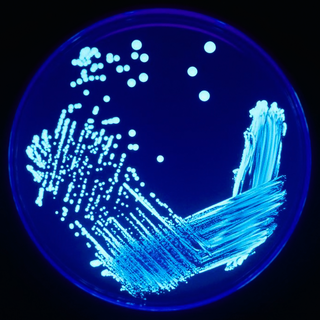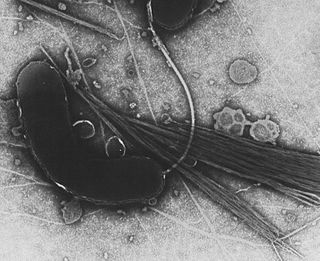
Pseudomonadota is a major phylum of Gram-negative bacteria. The renaming of several prokaryote phyla in 2021, including Pseudomonadota, remains controversial among microbiologists, many of whom continue to use the earlier name Proteobacteria, of long standing in the literature. The phylum Proteobacteria includes a wide variety of pathogenic genera, such as Escherichia, Salmonella, Vibrio, Yersinia, Legionella, and many others. Others are free-living (non-parasitic) and include many of the bacteria responsible for nitrogen fixation.

The Thiotrichales are an order of Pseudomonadota, including Thiomargarita magnifica, the largest known bacterium.

The Legionellales are an order of Pseudomonadota. Like all Pseudomonadota, they are Gram-negative. They comprise two families, typified by Legionella and Coxiella, both of which include notable pathogens. For example, Q fever is caused by Coxiella burnetii and Legionella pneumophila causes Legionnaires' disease and Pontiac fever.

The Methylococcaceae are a family of bacteria that obtain their carbon and energy from methane, called methanotrophs.

The Aeromonadales are an order of Pseudomonadota, with 10 genera in two families. The species are anaerobic. The cells are rod-shaped. Some species of this order are motile by a single polar flagellum; others are not motile.

The Cardiobacteriaceae are a family of Pseudomonadota, given their own order. They are Gram-negative and rod-shaped, with diameters around 0.5 to 1.7 μm and lengths from 1–6 μm.

The Alteromonadales are an order of Pseudomonadota. Although they have been treated as a single family, the Alteromonadaceae, they were divided into eight by Ivanova et al. in 2004. The cells are straight or curved rods. They are motile by the use of a single flagellum. Most of the species are marine.
The Thiotrichaceae are a family of Pseudomonadota, including Thiomargarita namibiensis, the largest known bacterium. Some species are movable by gliding, Thiospira by using flagella.
The Piscirickettsiaceae are a family of Pseudomonadota. All species are aerobes found in water. The species Piscirickettsia salmonis is a fish pathogen and causes piscirickettsiosis in salmonid fishes. It lives in cells of infected hosts and cannot be cultured on artificial media. Piscirickettsia salmonis is nonmotile, whereas the other five genera are motile by using a single flagellum.

The Moraxellaceae are a family of Gammaproteobacteria, including a few pathogenic species. Others are harmless commensals of mammals and humans or occur in water or soil. The species are mesophilic or psychrotrophic (Psychrobacter).
Oceanospirillaceae is a family of Pseudomonadota. Most genera in this family live in environments with high concentrations of salt; they are halotolerant or halophilic. They are marine, except Balneatrix which is found in fresh water and Venatorbacter, which is from terrestrial origin.All members are strictly aerobic, except Neptunomonas which can perform fermentation reactions.
The Alteromonadaceae are a family of Pseudomonadota. They are now one of several families in the order Alteromonadales, including Alteromonas and its closest relatives. Species of this family are mostly rod-like shaped and motile by using one polar flagellum.

The Aeromonadaceae are Gram-negative bacteria. The species are facultative anaerobic organisms. The cells are rod-shaped. They are mostly found in estuarine waters and fresh water, also in soil and sewage. Some are pathogenic for humans and other animals such as fishes and frogs.
The Ectothiorhodospiraceae are a family of purple sulfur bacteria, distinguished by producing sulfur globules outside of their cells. The cells are rod-shaped, vibrioid, or spirilla, and they are able to move using flagella. In general, they are marine and prefer anaerobic conditions. Ectothiorhodospiraceae are a vibrio bacteria that require salty living conditions to survive and grow: classifying them as slightly halophilic. Like all purple sulfur bacteria, they are capable of photosynthesis. To complete this energy process, Sulfur compounds are used as electron donors for carbon fixation in the pentose phosphate pathway. This elemental sulfur accumulates outside of the cells.

Betaproteobacteria are a class of Gram-negative bacteria, and one of the eight classes of the phylum Pseudomonadota.

Gammaproteobacteria is a class of bacteria in the phylum Pseudomonadota. It contains about 250 genera, which makes it the most genus-rich taxon of the Prokaryotes. Several medically, ecologically, and scientifically important groups of bacteria belong to this class. It is composed by all Gram-negative microbes and is the most phylogenetically and physiologically diverse class of Proteobacteria.
The Oceanimonas are a genus of marine bacteria. They are, like all Proteobacteria, gram-negative. The rod-shaped, motile organisms are aerobic and chemoorganotroph.
Oceanimonas doudoroffii is a Gram-negative marine bacterium. The rod-shaped, motile bacterium is aerobic and chemoorganotroph.
Pseudoalteromonas carrageenovora is a marine bacterium. It belongs to the Gammaproteobacteria. The cells are rod-shaped.

Acidithiobacillia is a class of the "Pseudomonadota". Its type order, the Acidithiobacillales, was formerly classified within the Gammaproteobacteria, and comprises two families of sulfur-oxidising autotrophs, the Acidithiobacillaceae and the Thermithiobacillaceae, which in turn include the genera Acidithiobacillus and Thermithiobacillus.










